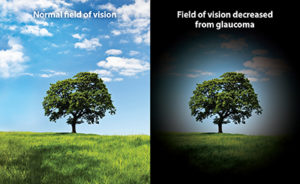GLAUCOMA TREATMENT

Glaucoma or ‘Kala Motia’ is a condition wherein an increased intraocular pressure damages the optic nerve thereby affecting vision. A fluid known as aqueous nourishes the front part of the eye. In the normal eye, the rate of production of aqueous matches the rate of its drainage, thereby maintaining optimal pressure inside the eye.
Glaucoma is also called the silent thief of sight because in the early stages of the disease, there may be no symptoms. By the time glaucoma is detected, the patient has already suffered extensive peripheral vision damage which can no longer be restored. Early detection is the key to preserve vision. Once detected, glaucoma can be controlled by medicines (eye drops) or surgery to prevent further vision loss. Treatment of Glaucoma is life-long. Glaucoma treatment may include medical management, surgical management or management by lasers.
The cause of glaucoma generally is a failure of the eye to maintain an appropriate balance between the amount of internal (intraocular) fluid produced and the amount that drains away.
Who Can Get it?
*Anyone can get glaucoma. But along with other factors, you are at a higher risk of getting it if it runs in your family. If a close first degree relative had it, then you should fix an annual eye checkup without fail.
* Diabetic/ Hypertensive indivisuals
*Prolonged use of oral/topical corticosteroids
*Following eye Trauma/inflammatory eye diseases such as uveitis.
*Myopic eyes
Symtoms:
- Seeing colored halos around lights
- Narrowing of vision (tunnel vision)
- Pain & Redness in the eye
- Hazy Cornea ( in infants)
- Nausea or vomiting, headache
- Frequent change of eye glasses
Types of Glaucoma:
There are two main types of glaucoma:
Open-angle glaucoma: Also called wide-angle glaucoma, this is the most common type of glaucoma. The structures of the eye appear normal, but fluid in the eye does not flow properly through the drain of the eye, called the trabecular meshwork.
Angle-closure glaucoma: Also called acute or chronic angle-closure or narrow-angle glaucoma, this type of glaucoma is less common in the West than in Asia. Poor drainage is caused because the angle between the iris and the cornea is too narrow and is physically blocked by the iris. This condition leads to a sudden buildup of pressure in the eye.
Treatment for Glaucoma?
Eye drops: When taken regularly and continuously as prescribed, eye drops control the eye pressure either by slowing the formation of aqueous fluid within the eye or by increasing the flow at the drainage area. The proper technique of using your medication is a key to successful treatment. Our glaucoma specialist or optometrist will teach you this technique.
Tablets: These are sometimes combined with the eye drops to decrease higher levels of eye pressure. They are occasionally known to cause tingling of fingers and toes, bowel irregularities, and in the very long term, kidney stones.
Laser surgery: Lasers are usually used in one of three ways:
- In open-angle glaucoma the draining angle itself is enlarged to control eye pressure.
- In angle-closure glaucoma the laser creates a hole in the iris to open up and improve the flow of aqueous fluid to the drain.
- In painful late-stage glaucoma medication or surgery do not control the pressure. The laser closes some aqueous fluid-producing areas in the eye and lowers the eye pressure.
Operative Surgery (Trabeculectomy)
- A new drainage channel is created for the drainage of aqueous fluid from the eye.
- Some cases may need a Specialized Glaucoma Valve Surgery.
- Surgery is recommended when our doctor feels that it is safer to operate than to allow optic nerve damage to continue.
- The best treatment for you should be decided after a thorough examination and discussion with your specialist.